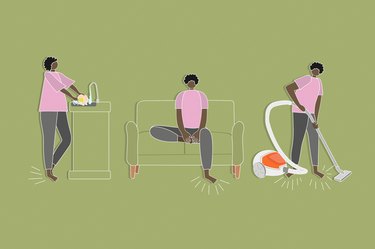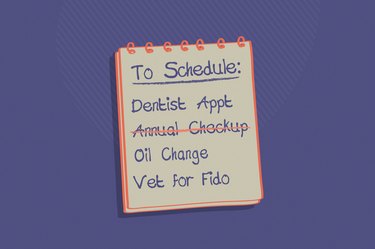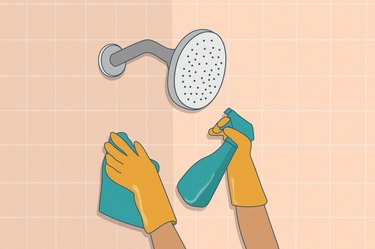
After a long day with our feet contained in cramped, stiff, narrow or generally uncomfortable shoes, many of us wiggle our toes in delight when we arrive at home. It's a thrill to release our tootsies and feel floorboards or carpet against our feet. But is going barefoot at home a welcome respite for our feet — or a potential cause of harm?
The answer: It depends.
Video of the Day
Video of the Day
"It's fine to go barefoot — but I don't think it's for everybody," William D. Spielfogel, DPM, chief of podiatry at Lenox Hill Hospital, tells LIVESTRONG.com.
Here's what you need to know before you spend a day inside shoe-free.
The Possible Risks of Going Barefoot on Your Feet
Going barefoot while you make your way through your day is unlikely to cause any problems unless you have an underlying issue with your feet.
Spending time sans shoes could cause pain and discomfort if you have any of the following foot conditions:
- Plantar fasciitis: This deeply painful — and all-too-common — foot condition occurs when the tissue connecting the heel to the ball of the foot is damaged or torn, per the American Academy of Orthopaedic Surgeons (AAOS). And while sometimes plantar fasciitis happens for an unknown reason, new or increased activity could be a factor, according to the AAOS. Wearing supportive shoes and not going barefoot is one of several potential remedies for plantar fasciitis, per the Mayo Clinic.
- Tendonitis: Several tendons are present in your feet, connecting muscles to bone, per Penn Medicine. With tendonitis, inflammation occurs in that tissue, causing pain.
- Morton's neuroma: Dr. Spielfogel says walking barefoot may exacerbate Morton's neuroma, a condition marked by pain or numbness in the ball of the foot or toes. Your risk of this condition increases if you wear heels or narrow shoes with a small toe box, and if you have flat feet, certain medical conditions (such as bunions) or play sports that place a lot of weight on the ball of your foot, per the Cleveland Clinic. The best shoes for Morton's neuroma have a wide toe box, good arch support and cushioning on the ball of the foot.
- Flat feet: "People with flat feet generally feel better when they have the support of a good shoe," says podiatrist Shannon Thompson, DPM, owner of Ace Feet in Boston, Massachusetts. Walking around barefoot over-works the foot for people with flat feet and can lead to aches and pains or cause other common foot issues, she says.
Plus, wearing something on your feet can protect you from the agony of stepping on a tack, sharp-edged toy or other small, sharp items that find their way to the floor.
This is uncomfortable for anyone but a bigger concern for people who have diabetes and a condition known as peripheral neuropathy (aka numbness in their feet), Dr. Spielfogel says. Those people could step on a sharp item but not experience pain and therefore not notice they have a wound that needs cleaning or bandaging, possibly leading to infection or, in severe cases, amputation.
Potential Benefits of Going Barefoot
If you love to free your feet from shoes and don't have any underlying foot issues that are causing you pain or discomfort, go for it.
Some possible benefits of going shoe-less include:
- It just feels nice: Don't discount the pleasure of going barefoot. It's nice to take a break from shoes sometimes. Your feet may feel free, and you'll get to air them out, says podiatrist Jacqueline Sutera, DPM, a member of Vionic Innovation Lab.
- It works some muscles: "We have all these little small intrinsic muscles in our feet," Dr. Spielfogel points out, and going barefoot can give them a small workout. "When barefoot, people tend to extend the toes a little more and can improve their flexibility," Dr. Thompson says.
- Can help with balance: When you're barefoot, you can "feel the ground," Dr. Thompson says. "This is helpful for maintaining balance," she says, which may be a concern for some older adults.
Tip
If you're used to wearing shoes all the time, going barefoot for long stretches all of a sudden may feel uncomfortable. Ease into the amount of time you spend shoe-free to avoid pain.
What Should You Wear at Home?
If you don't want to go barefoot at home, or if shedding shoes altogether causes you pain or discomfort, consider wearing a supportive slipper or house shoe to support good foot health.
Wearing the same shoes inside the house that you wear outside is "gross," Dr. Sutera says. (After all, they've likely come in contact with dog urine on streets, and who knows what other ickiness.)
"I recommend wearing supportive slippers, or even a dedicated pair of house sneakers for those who don't prefer slippers or who feel more stable in something that is closed/laced up," Dr. Sutera says.
You'll want your shoe or slipper to:
- Be comfortable: If you don't like having them on, you won't want to wear them.
- Provide arch support: These help "by distributing body weight across the feet and by cushioning the impact of walking," according to the University of Iowa Hospitals and Clinics.
- Have cushioning and shock absorption: You want a thicker sole and some cushioning to protect your foot from meeting the ground, Dr. Sutera says. "Avoid thin, flat and flimsy slippers," she says. Flip-flops are also generally a no-go. Having some cushioning is particularly important as you get older and the natural fat pads on the bottom of your feet begin to atrophy, Dr. Spielfogel says. With your own natural cushioning diminished, having some in your house shoe or slipper helps.
And, once it's time, get a new pair of slippers or house shoes, Dr. Sutera says. "Replace slippers if there are any signs of wear or it looks like the soles are uneven," she says.
When to See a Podiatrist
If your feet hurt, don't hold off on seeing a podiatrist.
"It's not normal to be in pain," Dr. Spielfogel says. He often sees patients who mention having pain for several months before making an appointment and wonders what took them so long.
"If you catch something early enough, most of the time we can treat things conservatively," Dr. Spielfogel says. That might mean icing the area, stretching or taking over-the-counter anti-inflammatory pain relievers. Other interventions are more serious, including surgery, he notes.
So, How Bad Is It Really to Go Barefoot at Home?
Spending time barefoot isn't a problem unless you have peripheral neuropathy in your feet or if going shoeless is uncomfortable.
"If your feet aren't in pain and you generally don't have any foot problems, it's definitely OK to go barefoot at home," Dr. Thompson says.
If that's the cause, you might even reap some benefits of walking in bare feet, including strengthening your stabilizing muscles and improving your balance.
Is this an emergency? If you are experiencing serious medical symptoms, please see the National Library of Medicine’s list of signs you need emergency medical attention or call 911.


